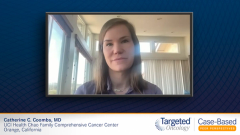
Overview of Treatment Options for Relapsed/Refractory CLL
Catherine C. Coombs, MD, reviews currently available treatment options for patients with relapsed/refractory chronic lymphocytic leukemia.
Episodes in this series

Case: A 70-Year-Old Man with R/R Chronic Lymphocytic Leukemia (CLL)
- Patient AL is a 70 y/o man.
- PMH: T2DM and Hypertension (both well controlled with medication)
- SMH: Does not smoke or drink alcohol.
Clinical Presentation:
- In July 2022, AL was diagnosed with CLL and had been previously treated with venetoclax plus obinutuzumab upon initial diagnosis. Less than 6 months later, AL presented to his oncologist reporting an unresolved fever and increased fatigue.
Clinical Workup and Molecular Testing:
- Laboratory Findings:
- WBC: 120,000
- Hgb, 9.1 g/dL
- Platelets, 92 x 109/L
- Molecular Testing:
- Elevated serum beta-2-microglobulin
- Flow cytometry, CD5+, CD19+, CD23+
- IGHV/TP53 mutational status: unmutated
- FISH detect del(17p)
- ECOG PS 1
Disease Relapse and Treatment(s):
- Further disease progression was documented, and a joint decision was made to initiate AL on venetoclax plus rituximab.
- Venetoclax Dosing Ramp-Up Schedule
- Starting dose of 20 mg PO QD x 7 days, then weekly ramp up to 50 mg, 100 mg, 200 mg, and 400 mg PO daily. The recommended daily dose (400 mg) continues from week 5 and beyond for 24 months.
- Rituximab 375 mg/m2 on C1D1 (28-day cycle), then 500 mg/m2 on Day 1 for 5 cycles (completing after month 6).
- Venetoclax Dosing Ramp-Up Schedule
Transcript:
Catherine C. Coombs, MD: The currently available treatment approaches in patients with relapsed and refractory CLL [chronic lymphocytic leukemia] are many. The most commonly utilized agents in my own practice include novel therapies, including BTK [Bruton tyrosine kinase] inhibitors, including acalabrutinib, zanubrutinib, and ibrutinib as well, though that is no longer listed as a preferred regimen due to its less favorable [adverse] effect profile as compared with the newer agents. The second class is BCL2 inhibitors, in which venetoclax is the only FDA approved agent. There are a number of other options, including PI3 kinase inhibitors. I find myself using those a lot less often due to the unfavorable toxicity profile. I also have questions on the efficacy of these agents given that their FDA approval was based on patients who were BTK inhibitor–naïve, and we know that they don’t perform as well in patients who had a prior BTK inhibitor, at least based on real-world studies.
We also use anti-CD20 monoclonal antibodies. Venetoclax, per its NCCN [National Comprehensive Cancer Network] label, is paired with rituximab, which is based on the MURANO trial [NCT02005471] that led to its FDA approval as a time-limited therapy in the relapsed/refractory setting. Many of us consider using obinutuzumab, even in the relapse setting, instead of rituximab, given that we now have multiple trials that demonstrate clear superiority with respect to efficacy of obinutuzumab over rituximab.
The caveat to these studies is that these were all frontline trials, the most relevant being the CLL13 trial [NCT02950051], where the combination of venetoclax with obinutuzumab had vastly superior rates of undetectable MRD [minimal residual disease] as compared with venetoclax and rituximab. Again, that was a frontline study. It was only 1 year of venetoclax. So my honest opinion is both CD20s probably work pretty well, but if obinutuzumab is approved by the patient’s insurance, I tend to pull toward that, even in the relapse setting, but always in the first-line setting given that was the design of the CLL14 trial [NCT02242942].
Allogeneic stem cell transplant is a consideration; I will say I use that very sparingly because it’s a very toxic therapeutic modality. When you look at the average patient with CLL, the average age of diagnosis is around 71. So by the time they need therapy and by the time they’re failed by our existing therapies, many are unfortunately too old to consider this modality, which can have significant morbidity and mortality associated with it. So I reserve that for very high-risk patients who are younger. But even then, with the novel therapies that we have, it’s something that I very infrequently use.
Transcript edited for clarity.







































